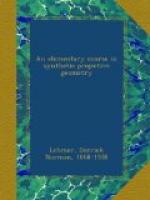148. Axes of conics. At the close of the last chapter (§ 140) we gave the theorem: A conic determines at every point in its plane an involution of rays, corresponding rays _ being conjugate with respect to the conic. The double rays, if any exist, are the tangents from the point to the conic._ In particular, taking the point as the center of the conic, we find that conjugate diameters form a system of rays in involution, of which the asymptotes, if there are any, are the double rays. Also, conjugate diameters are harmonic conjugates with respect to the asymptotes. By the theorem of the last paragraph, there are two conjugate diameters which are at right angles to each other. These are called axes. In the case of the parabola, where the center is at infinity, and on the curve, there are, properly speaking, no conjugate diameters. While the line at infinity might be considered as conjugate to all the other diameters, it is not possible to assign to it any particular direction, and so it cannot be used for the purpose of defining an axis of a parabola. There is one diameter, however, which is at right angles to its conjugate system of chords, and this one is called the axis of the parabola. The circle also furnishes an exception in that every diameter is an axis. The involution in this case is circular, every ray being at right angles to its conjugate ray at the center.
149. Points at which the involution determined by a conic is circular. It is an important problem to discover whether for any conic other than the circle it is possible to find any point in the plane where the involution determined as above by the conic is circular. We shall proceed to the curious problem of proving the existence of such points and of determining their number and situation. We shall then develop the important properties of such points.
150. It is clear, in the first place, that such a point cannot be on the outside of the conic, else the involution would have double rays and such rays would have to be at right angles to themselves. In the second place, if two such points exist, the line joining them must be a diameter and, indeed, an axis. For if F and F’ were two such points, then, since the conjugate ray at F to the line FF’ must be at right angles to it, and also since the conjugate ray at F’ to the line FF’ must be at right angles to it, the pole of FF’




